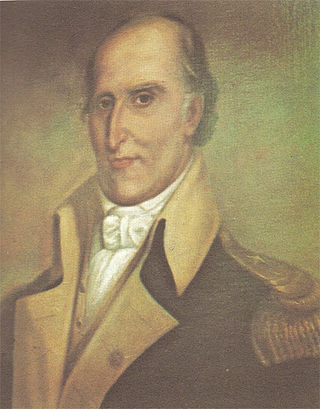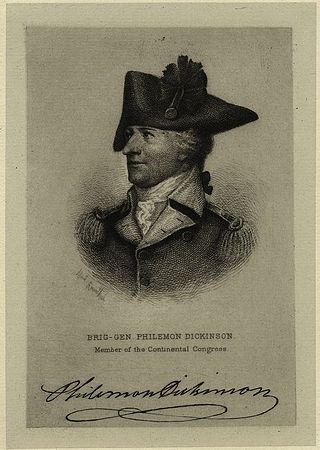
William Richardson Davie was an American statesman, politician, military general, Founding Father of the United States who served as the 10th Governor of North Carolina from 1798 to 1799. A member of the Federalist Party, Davie also served as a delegate to the Constitutional Convention as a representative of North Carolina. He is also one of the key founders of the University of North Carolina.

The Battle of Kings Mountain was a military engagement between Patriot and Loyalist militias in South Carolina during the Southern Campaign of the American Revolutionary War, resulting in a decisive victory for the Patriots. The battle took place on October 7, 1780, 9 miles (14 km) south of the present-day town of Kings Mountain, North Carolina. In what is now rural Cherokee County, South Carolina, the Patriot militia defeated the Loyalist militia commanded by British Major Patrick Ferguson of the 71st Foot. The battle has been described as "the war's largest all-American fight".

The Battle of Cowpens was a military engagement during the American Revolutionary War fought on January 17, 1781, near the town of Cowpens, South Carolina. American Patriot forces, estimated at 2,000 militia and regulars under Brigadier General Daniel Morgan faced 1,000 British troops under Lieutenant Colonel Banastre Tarleton.
The Waxhaws is a geographical region extending beyond both sides of the border between what now is North Carolina and South Carolina, United States. It encompasses the areas currently known as Lancaster, Union and Mecklenburg counties. The name is derived from that of the Indigenous people who first inhabited the landbase, the Waxhaw people. Much of the area is now the territory of the Catawba Indian Nation.

The Battle of Kettle Creek was the first major victory for Patriots in the back country of Georgia during the American Revolutionary War that took place on February 14, 1779. It was fought in Wilkes County about eleven miles (18 km) from present-day Washington, Georgia. A militia force of Patriots decisively defeated and scattered a Loyalist militia force that was on its way to British-controlled Augusta.

The Battle of Fishing Creek, also called the Battle of Catawba Ford, was an American Revolutionary War battle fought on August 18, 1780, between American and British forces including the 71st Foot. It was fought near the junction of Fishing Creek and the Catawba River in South Carolina. British forces under Banastre Tarleton surprised the militia company of Thomas Sumter, killing a significant number, taking about 300 captives, and very nearly capturing Sumter, who some say was asleep at the time of the attack.

The southern theater of the American Revolutionary War was the central theater of military operations in the second half of the American Revolutionary War, 1778–1781. It encompassed engagements primarily in Virginia, Georgia, North Carolina, and South Carolina. Tactics consisted of both strategic battles and guerrilla warfare.

The Battle of Millstone, also known as the Battle of Van Nest's Mill, was a skirmish that occurred near the mill of Abraham Van Nest in Weston, New Jersey on January 20, 1777, during the American Revolutionary War. A British foraging party was flanked and driven off by forces composed mostly of New Jersey militia, depriving the British of their wagons and supplies.

The Battle of Charlotte was an American Revolutionary War battle fought in Charlotte, North Carolina on September 26, 1780. The battle took place at the Mecklenburg County Court House; which is now the site of the Bank of America tower at Trade and Tryon Streets in uptown Charlotte. An advance guard of General Charles Cornwallis' army rode into town and encountered a well-prepared Patriot militia under the command of William R. Davie in front of the court house. A skirmish ensued in which George Hanger, leading the British cavalry, was wounded. The small Patriot force, which had not intended more than token resistance, withdrew north toward Salisbury upon the arrival of Cornwallis and the main army.
The Battle of Cowan's Ford took place in the Southern Theater of Cornwallis's 1780–1782 Campaign during the American Revolutionary War. It was fought on February 1, 1781, at Cowan's Ford on the Catawba River in northwestern Mecklenburg County, North Carolina, between a force of about 2,400 British and about 800 Whig (Patriot) militia who were attempting to slow the British advance across the river. The American general William Lee Davidson was killed in this battle.

Griffith Rutherford was an American military officer in the Revolutionary War and the Cherokee-American Wars, a political leader in North Carolina, and an important figure in the early history of the Southwest Territory and the state of Tennessee.

Frederick Hambright was a military officer who fought in both the local militia and in the North Carolina Line of the Continental Army during the Revolutionary War. He is best known for his participation in the Battle of Kings Mountain in 1780. Serving as a statesman early in the Revolution, Hambright joined the war in 1777, ranked a lieutenant colonel in a local militia. His early actions were limited to occasional checks on Loyalist groups. This changed in 1780 with Hambright's important role at the Battle of Kings Mountain, which occurred near his lands in the newly formed Lincoln County, North Carolina. Hambright was commended for his bravery during the battle, though suffering a wound which forced him to permanently resign from military service.

The Battle of Torrence's Tavern was a minor engagement of the American Revolutionary War that took place in what was the western portion of Rowan County, North Carolina, approximately 10 miles (16 km) east of the Catawba River near modern-day Mooresville in Iredell County. Torrence's Tavern was a part of the larger Southern campaign of the American Revolution, which, by 1780–1781 involved a series of clashes between the British Army and Loyalist militia and the Continental Army and Patriot militia in the Piedmont region of North and South Carolina.

Thomas Polk was a planter, military officer in the Continental Army during the American Revolutionary War from 1775 to 1781, and a politician who served in the North Carolina House of Commons, North Carolina Provincial Congress, and Council of State. Polk commanded the 4th North Carolina Regiment in the Battle of Brandywine. In 1786, Polk was elected by the North Carolina General Assembly to the Congress of the Confederation, but did not attend any of its sessions. Polk was a great-uncle of the 11th President of the United States, James K. Polk.
Colonel Robert Irwin of Steele Creek Township, Mecklenburg County, North Carolina was a long term North Carolina State Senator. The first state senator ever elected from Mecklenburg County, he served as the North Carolina senator from Mecklenburg County in the years 1778-1783, and again, in the years 1787 and 1795, and, finally, from 1797 to 1800, dying in office.
The Mecklenburg County Regiment was authorized on May 31, 1775 by the Province of North Carolina Congress. From November 7, 1779 until the 3rd Quarter of 1780, it was called the 1st Mecklenburg County Regiment when a 2nd Mecklenburg County Regiment existed. The 1st Mecklenburg County regiment was engaged in 39 known battles and skirmishes against the British during the American Revolution in North Carolina, South Carolina and Georgia between 1776 and 1781. It was active until the end of the war.
The Edenton District Brigade was an administrative division of the North Carolina militia during the American Revolutionary War (1776–1783). This unit was established by the North Carolina Provincial Congress on May 4, 1776, and disbanded at the end of the war.
North Carolina state troops in the American Revolution were the initial military units created in a transition from the Province of North Carolina under British rule to independence from British rule. Most units did not last long as such and were either transferred to the Continental Army or state militia instead.
The Warren County Regiment was established on January 3, 1779 by the North Carolina General Assembly when Bute County and its Regiment of militia were abolished. The regiment was engaged in battles and skirmished in North Carolina, South Carolina, and Georgia.

Joseph Graham was a Revolutionary War militia officer, politician, and wealthy ironmonger from Mecklenburg County, North Carolina.











